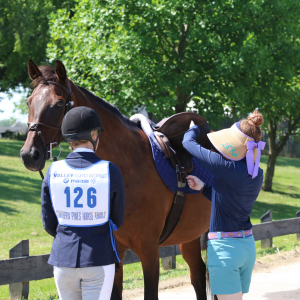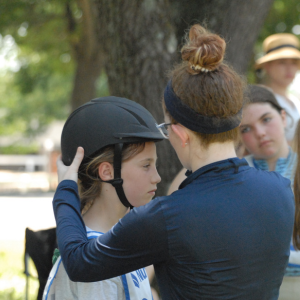
Since its founding, the United States Pony Club has led the equestrian community in promoting safe horsemanship practices. Recognizing that riding is an inherently dangerous activity, the USPC Board of Governors endorses the goal to teach safe practices in all Pony Club activities. The commitment to teach safe practices begins at the D-1 and D-2 levels when members learn how to safely approach a horse or pony, lead and tie, and safely pick out the feet. These steps are the foundation for learning the safe handling of a very large animal capable of causing serious bodily injury or death to itself or a rider/handler.
To further Pony Club's commitment to safety, the Safety Committee was formed for the purpose of promoting best practices in riding and working with horses and educating those involved with all Pony Club activities in the methods of incident and accident avoidance. A full list of the duties of the national Safety Committee can be found in USPC Resolution #9.
USPC was the driving force behind the standardization in safety testing of riding helmets. For many years, Pony Club was the only equestrian organization that collected data on accidents and incidents that result from horseback riding or working with horses on the ground. The study of the collected data by the Safety Committee allows for Pony Club to recognize potential causes of accidents unique to horse activities and possible actions that might be taken to prevent or reduce these risks.
Pony Club is a leader in gathering information about events that could, or do, result in injury associated with horsemanship. This information includes not only those incidents that lead to injury during riding, but also those that may occur during grooming or any other function associated with the care or transport of the horse. The information obtained from USPC yearly surveys has led to significant improvements in safety and has reduced the number of injuries for all riders.

USPC Policy 0800 - Safety:
The policy of the Board of Governors is that The United States Pony Clubs, Inc. shall be committed to the safety of all associated with any Pony Club activity. Recognizing that riding and Horse Management activities are inherently dangerous, the Board has approved safety regulations, guidelines, programs, and requirements to teach and promote safety in all its activities, as well as the safe handling and care of our equine partners. These include, but may not be limited to, required safety attire for riders and horse handlers; requirements pertaining to mounts, bitting, veterinary care, and equine medications.
For specifics on USPC Safety Policies & Procedures, please visit the USPC By-Laws, Policies, & Resolutions page, Corporate Safety section.
Read the By-Laws, Policies, & Resolutions
The United States Pony Clubs, Inc. (USPC or Pony Club) announced changes to its safety policies and tack allowances that involve helmets, body protection vests, and stirrups. These changes affect all USPC participating members and members participating in a Pony Club event from another organization, such as during an international exchange. Learn more about the changes that go into effect January 1, 2025.
Read the important safety updates

As a youth-serving organization committed to the safety and security of members and volunteers, USPC must adhere to best practices by requiring a favorably completed background check on an individual’s record. Regular instructors/clinicians, local-level examiners, and leaders/volunteers having ongoing contact with members, as well as adult members over 21, are required to complete a favorable background check.
The HEADS UP to Youth Sports training module was produced by the National Football League (NFL) and the Centers for Disease Control (CDC) Foundation. Once an individual has completed the module, a short quiz from Pony Club must be taken as a proof of training completion.
More on Head Injury and Concussion
The Recognizing, Preventing, and Treating Heat-Related Illness training module was produced by the CDC Foundation. Once an individual has completed the module, a short quiz from Pony Club must be taken as a proof of training completion.
Regular instructors/clinicians, local-level examiners, and leaders/volunteers having ongoing contact with members, as well as adult members, are required to provide proof of SafeSport™ Trained Core course completion.
The comprehensive SafeSport™ Trained Core course helps individuals recognize if an athlete is being abused, and most importantly, how to prevent this from happening, or how to respond and help if the abuse has already occurred. Education and awareness are the most critical components to creating safe and respectful sport environments.
Review the list of required and available requirements/trainings for the various positions in Pony Club. Requirements vary based on leadership and volunteer positions.

Biosecurity should be a consideration for Pony Club leaders organizing lessons, camps, and rallies. Considerations should also be taken by members and parents. This document provides best practices guidelines for Pony Club activities.

In accordance with USPC Policy 0810, a properly fitted equestrian helmet, securely fastened, containing certification that it meets or exceeds the criteria established by a national or international safety body is required to participate in any USPC activity. Read more from the Horse Management Handbook–Section V: Chapter 16.
More details on proper helmet fit can be found on the Centers for Disease Control and Prevention's (CDC) website. Read more.
In accordance with USPC Policy 0820 & 0820 P.1, a Pony Club member must wear a medical armband or bracelet at all Pony Club activities. Information cards and online records should be updated regularly. Read the frequently asked questions document below for more details regarding medical armband and bracelet requirements.
Frequently Asked Questions | Purchase a Medical Armband | Download a Blank Medical Card

In accordance with USPC Policy 0830, Pony Club requires a body protector whenever a member is jumping cross-country/solid obstacles in Pony Club activities.
Learn more about Safety Vest Fit and read the Equestrian Body Protectors Guide.

In order to improve the safety of our members and volunteers when riding and working around horses, club, center, and regional leaders are required to complete an Incident Report Form within 24 hours of the event/activity when ANY incident occurs at a Pony Club activity. This form MUST be filled out whether it appears to be a minor bump or a significant injury.
Incident Report Forms are reviewed by the Safety Committee to look for trends and patterns in injuries and to find solutions with which to reduce the risk of injury to human or animal.
Read the article - Pony Club Incident Reports (Discover USPC, #162)
Digital Incident Report Form | Download the Incident Report Form
Timely recognition and appropriate response is important in treating a mild traumatic brain injury (MTBI) or concussion. Pony Club leaders and instructors play a key role in helping to prevent a concussion and to improve outcomes through early detection and appropriate referral. Use the Concussion Assessment Tool to assess the possibility that a member may have a concussion.
Traumatic Brain Injuries are specific injuries Pony Club is working towards learning more about as they relate to occurrence in equestrian sports. Pony Club is committed to educating our members, parents, and leaders on the signs and treatments. The form below is to be completed to report the particulars of a member returning to play following a head injury or suspicion of a concussion.
This form should be given to any member or their parent whenever a member has suffered a suspected head injury or concussion. This form should be completed and signed by a physician and the member or parent/guardian (if the member is a minor) and submitted to their club/center leader before they are allowed to participate again in a Pony Club activity.
Download the Return to Play Form

This handbook provides members, leaders, volunteers, and parents helpful safety guidelines as they begin planning for successful mounted and unmounted meetings, rallies, and other equestrian activities.
Learn more about the Guidelines for Delay, Cancellation, or Disruption of Events Due to Severe Weather or Natural Disasters.
Read the Safety Handbook | Purchase the Safety Handbook
Guidance on qualified medical personnel required at rallies.